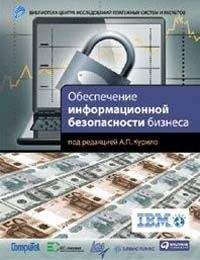Майкл Мобуссин - Больше, чем вы знаете. Необычный взгляд на мир финансов
3. Kenneth L. Fisher and Meir Statman, “Cognitive Biases in Market Forecasts: The Frailty of Forecasting”, The Journal of Portfolio Management 27, no. 1 (Fall 2000): 72–81.
4. Alfred Rappaport, “How to Avoid P/E Trap”, Wall Street Journal, March 10, 2003.
5. Cornell, The Equity Risk Premium, 59.
6. См.: http://www.econ.yale.edu/˜shiller/.
Глава 25. Я упал и не могу подняться
1. Слова Лаконишока процитированы в статье Марка Хулберта «Прогнозы на ближайшие пять лет кажутся превосходными… или нет?», New York Times, от 25 января 2004 г.
2. Louis K. C. Chan, Jason J. Karceski, and Josef Lakonishok, “The Level and Persistence of Growth Rates”, The Journal of Finance 58, no. 2 (April 2003): 644–84. Также см. главу 30.
3. Michael J. Mauboussin and Kristen Bartholdson, “Wither Enron: Or – Why Enron Withered”, The Consilient Observer 1, no. 1 (January 15, 2002).
4. Michael J. Mauboussin and Kristen Bartholdson, “Measuring the Moat: Assessing the Magnitude and Sustainability of Value Creation”, Credit Suisse First Boston Equity Research, December 16, 2002.
5. Michael J. Mauboussin, Alexander Schay, and Patrick J. McCarthy, “Competitive Advantage Period (CAP): At the Intersection of Finance and Competitive Strategy”, Credit Suisse First Boston Equity Research, October 4, 2001.
6. Там же, 7–9.
7. Todd Erickson, Carin Cooney, and Craig Sterling, “US Technology Sector: Mean Reversion Analysis”, CSFB HOLT Research, February 2, 2004.
8. Анализ отрасли розничной торговли проведен аналитиками из агентства HOLT Кристофером Катапано, Кэти Данн и Крейгом Стерлингом.
9. Чтобы проиллюстрировать вышесказанное, нами была создана модель, включавшая две компании с одинаковыми темпами роста операционной прибыли на уровне 8 %, одинаковой начальной рентабельностью приращенного инвестированного капитала в 100 % и идентичной стоимостью капитала. Согласно модели, рентабельность первой компании упала до нуля за 10-летний период, рентабельность второй компании – за 20 лет. Стоимость второй компании (при аналогичном росте) оказалась на 33 % выше, что дало ей разницу в показателе цены/прибыли более чем в шесть пунктов.
10. W. Brian Arthur, “Increasing Returns and the New World of Business”, Harvard Business Review (July-August 1996): 101–9.
11. См. главу 11.
Глава 26. Сотрудничество в позиционной войне
1. Robert Axelrod, The Complexity of Cooperation: Agent-Based Models of Competition and Collaboration (Princeton, N. J.: Princeton University Press, 1997), 6.
2. Robert Axelrod, The Evolution of Cooperation (New York: Basic Books, 1984), 74.
3. George Lakoff and Mark Johnson, Metaphors We Live By (Chicago, Ill.: The University of Chicago Press, 1980).
4. Axelrod, The Evolution of Cooperation, 73–87.
5. Там же, 81. Аксельрод цитирует Гиллана по книге «История 29-й дивизии»; см.: S. Gillon, The Story of the 29th Division (London: Nelson & Sons, n. d.). В конце концов командованиям британской, французской и германской армий удалось разрушить систему «живи сам и давай жить другим», заставив войска на передовой совершать постоянные рейды, которые нарушили стабильность, требуемую для поддержания негласного перемирия.
6. “Stern Stewart EVA Roundtable”, Journal of Applied Corporate Finance 7, no. 2 (Summer 1994): 46–70.
7. Детальное обсуждение этой темы см.: William Poundstone, Prisoner’s Dilemma (New York: Anchor Books, 1972).
8. Решение расширить мощности приводит обе компании к равновесию Нэша.
9. Axelrod, The Evolution of Cooperation, 27–54.
10. David Besanko, David Dranove, and Mark Shanley, Economics of Strategy, 2nd ed. (New York: John Wiley & Sons, 2000), 289–90.
11. Там же, 293–302.
12. Adam M. Brandenburger and Barry J. Nalebuff, Co-opetition (New York: Currency, 1996), 120–22.
Глава 27. Большие ожидания (роста)
1. Warren Buffet and Charlie Munger, “It’s Stupid the Way People Extrapolate the Past – and Not Slightly Stupid, But Massively Stupid”, Outstanding Investor Digest, December 24, 2001.
2. Chris Zook and James Allen, Profit from the Core (Boston: Harvard Business School Press, 2001), 11–13.
3. Я упоминаю об этом, поскольку многочисленные данные говорят о том, что слияния и приобретения оказывают отрицательное или, в лучшем случае, нейтральное влияние на стоимость. Поэтому рост через приобретения часто не приводит к повышению стоимости.
4. О распределении Зипфа см.: Robert L. Axtell, “Zipf Distribution of U. S. Firm Sizes”, Science 293 (September 2001); 1818–1820.
5. Это не совсем правильное употребление термина «закон больших чисел». Более подробное объяснение см.: Peter L. Bernstein, Against the Gods: The Remarkable Story of Risk (New York: John Wiley and Sons, 1996), 122–23.
6. Jeremy J. Siegel, Stocks for the Long Run, 3rd ed. (New York: McGraw Hill, 2002), 150–56.
7. Joseph Fuller and Michael C. Jensen, “Dare to Keep Your Stock Price Low”, The Wall Street Journal, December 31, 2001.
8. Alfred Rappaport, “The Economics of Short-Term Performance Obsession”, Financial Analysts Journal 61, no. 3 (May-June 2005): 65–79.
Часть IV. Наука и теория сложности
Глава 28. Разнообразьте свое мышление
1. См. доклад Нормана Джонсона «Чем полезен более широкий взгляд на вещи (или Падение Дома экспертов)» на Форуме новаторов в CSFB, сентябрь 2000 г., Санта-Фе, Нью-Мексико; http://www.capatcolumbia.com/CSFBTLF/
2. 2000/johnson00_sidecolumn.pdf.
3. Michael J. Mauboussin, “Revisiting Market Efficiency: The Stock Market as a Complex Adaptive System”, Journal of Applied Corporate Finance 14. No. 4 (Winter 2002): 47–55.
4. Norman L. Johnson, “Diversity in Decentralized Systems: Enabling Self-Organizing Solutions”, LANL, LA-UR-99–6281, 1999. Дополнительную информацию на эту тему см. на сайте: http://ishi.lanl.gov.
5. James Kennedy and Russell C. Eberhart, Swarm Intelligence (San Francisco: Morgan Kaufmann, 2001), 105.
6. William H. Calvin, “The Emergence of Intelligence”, Scientific American Presents 9, no. 4 (November 1998): 44–51.
7. Gary Klein, Sources of Power: How People Make Decisions (Cambridge, Mass.: MIT Press, 1998).
8. Michael T. Kaufman, Soros: The Life and Times of a Messianic Billionaire (New York: Knopf, 2002), 141.
9. См. статью «Неформальное обучение на рабочем месте» на сайте http://www.learning-org.com/98.01/0331.html.
10. Arthur Zeikel, “Organizing for Creativity”, Financial Analyst Journal 39 (November-December 1983): 25–29.
Глава 29. От меда до денег
1. Thomas D. Seeley, The Wisdom of the Hive: The Social Psychology of Honey Bee Colonies (Cambridge, Mass.: Harvard University Press, 1995), 259. Также см.: http://www.pbs.org/wgbh/nova.bees.
2. Цит. по Steven Johnson, Emergence: The Connected Lives of Ants, Brains, Cities, and Software (New York: Scribner, 2001), 33.
3. Seeley, The Wisdom of the Hive, 240–62; также см.: http://www.nbb.cornell.edu/neurobio/
4. department/Faculty/seeley/seeley.html.
5. Eric Bonabeau, Marco Dorigo, and Guy Theraulaz, Swarm Intelligence: From Natural to Artificial Systems (New York: Oxford University Press. 1999), 39–55. Также см. Edmund Burke and Graham Kendall, “Applying Ant Algorithms and the No Fit Polygon to the Nesting Problem”, University of Nottingham Working Paper, 1999; http://www.asap.cs.nott.ac.uk/publications/pdf/gk_ai99.pdf.
6. Сайт IEM: http://www.biz.uiowa.edu/iem.
7. James Surowiecki, “Decisions, Decisions”, The New Yorker, March 28, 2003, доступно на сайте http://www.newyorker.com/archive/2003/
8. 03/24/030324ta_talk_surowiecki.
9. Сайт фондовой биржи Голливуда: http://www.hsx.com.
10. Сайт биржи BetFair: http://www.betfair.com.
11. Alfred Rappaport and Michael J. Mauboussin, Expectations Investing (Boston, Mass.: Harvard Business School Press, 2001), 132–34.
12. Howard Rheingold, Smart Mobs: The Next Social Revolution (New York: Perseus, 2002).
13. Ken Brown, “Stocks March to the Beat of War, Weak Economy”, Wall Street Journal, March 31, 2003.
Глава 30. Глас народа
1. Michael Idinopulos and Lee Kempler, “Do You Know Who Your Experts Are?” The McKinsey Quarterly 4 (2003): 60–69; см.: http://www.mckinseyquarterly.com/
2. article_abstract.asp?ar=1358&L2=18&L3=31&srid=6&gp=1.
3. Nancy Weil, “Innocentive Pairs R&D Challenges with Researchers”, Bio-IT World, May 29, 2003.
4. Некоторые компании пытаются создать внутренний механизм поиска решений конкретных проблем. Например, в Hewlett-Packard действует система, которая называется SHOCK (Social Harvesting of Community Knowledge – Общество пожинает плоды знаний пользователей); см.: http://www.hpl.hp.com/research/idl/projects/shock.
5. Francis Galton, “Vox Populi”, Nature 75 (March 7, 1907): 450–451; reprint 1949. James Surowiecki, The Wisdom of Crowds: Why the Many Are Smarter Than the Few and How Collective Wisdom Shapes Business, Economies, Societies and Nations (New York: Doubleday, 2004).
6. Norman L. Johnson, “Collective Problem Solving: Functionality Beyond the Individual”. LA-UR-98–2227 (1998); Jack L. Treynor, “Market Efficiency and the Bean Jar Experiment”, Financial Analysts Journal (May-June 1987): 50–53; Sherry Sontag and Christopher Drew, Blind Man’s Bluff: The Untold Story of America Submarine Espionage (New York: Perseus Books, 1998), 58–59.
7. Kay-Yut Chen, Leslie R. Fine, and Bernardo A. Huberman, “Predicting the Future”, Information Systems Frontiers 5, no. 1 (2003): 47–61, http://www.hpl.hp.com/shl/papers/future/future.pdf.
Глава 31. Миром правят толстые хвосты
1. Альберт Эйнштейн считал, что броуновское движение взвешенной в воде пыльцы является результатом хаотичных толчков теплового движения со стороны молекул воды.
2. См.: GloriaMundi, “Introduction to VaR”, http://www.gloriamundi.org/introduction.asp.
3. Edgar E. Peters, Fractal Market Analysis (New York: John Wiley & Sons, 1994), 21–27.
4. Roger Lowenstein, When Genius Failed: The Rise and Fall of Long-Term Capital Management (New York: Random House, 2000), 72. Ловенстейн цитирует статью Дженса Карстена Джекверта и Марка Рубинстайна (Jens Carsten Jackwerth and Mark Rubinstein, “Recovering Probability Distributions from Option Prices”, Journal of Finance 51, no. 5 (December 1996): 1612). Джекверт и Рубинстайн отмечают, что если исходить из волатильности рынка в годовом исчислении на уровне 20 % и логнормального распределения, то 29 %-ное падение цены фьючерсов на S&P 500 является событием в диапазоне 27 стандартных отклонений и с вероятностью 10–160.
5. Per Bak, How Nature Works (New York: Springer-Verlag, 1996).
6. См. главу 22.
7. Suchil Bikchndani and Sunil Sharma, “Herd Behavior in Financial Markets”, IMF Staff Paper 47, no. 3 (2001), http://www.imf.org/External/Pubs/FT/
8. staffp/2001/01/pdf/bikchan.pdf.
9. Michael S. Gibson, “Incorporating Event Risk into Value-and-Risk”, The Federal Reserve Board Finance and Economics Discussion Series, 2001–17 (February 2001); http://www.federalreserve.gov/pubs/feds/
10. 2001/200117/200117abs.html.
Глава 32. Интегрируя частности
1. Daniel Bernoulli, “Exposition of a New Theory on the Measurement of Risk”, Econometrica, 22 (January 1954): 23–36. Впервые статья была опубликована в 1738 г. Саму игру изначально предложил двоюродный брат Даниила – Николаус.
2. См.: Стэнфордская философская энциклопедия, статья «Санкт-петербургский парадокс», http://plato.stanford.edu/entries/paradox-stpetersburg.



